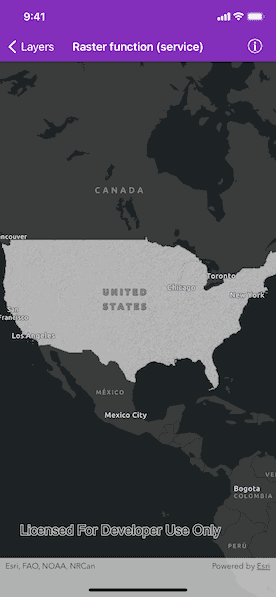Load a raster from a service, then apply a function to it.

Use case
Raster functions allow processing operations that can be applied to one or more rasters on the fly. Functions can be applied to rasters that come from a service. A land survey agency may apply hillshade and aspect functions to rasters with elevation data in order to better determine the topography of a landscape and to make further planning decisions.
How to use the sample
The raster function is applied automatically when the sample starts and the result is displayed.
How it works
- Create an
AGSImageServiceRasterwith the image server URL. - Create an
AGSRasterFunctionfrom a JSON string. - Get the name of the first raster name from the raster function's
rasterNamesarray. - Set the raster argument with
AGSRasterFunctionArguments.setRaster(_:withName:). - Create a new
AGSRasterreferring to the raster function. - Create an
AGSRasterLayerto visualize the computed raster. - Display the raster.
Relevant API
- AGSImageServiceRaster
- AGSRaster
- AGSRasterFunction
- AGSRasterFunctionArguments
- AGSRasterLayer
About the data
The sample applies a hillshade function to a raster produced from the National Land Cover Database, NLCDLandCover2001. You can learn more about the hillshade function in the ArcMap documentation.
Additional information
The raster function computation happens locally on the client device.
Tags
function, layer, raster, raster function, service
Sample Code
//
// Copyright 2017 Esri.
//
// Licensed under the Apache License, Version 2.0 (the "License");
// you may not use this file except in compliance with the License.
// You may obtain a copy of the License at
//
// http://www.apache.org/licenses/LICENSE-2.0
//
// Unless required by applicable law or agreed to in writing, software
// distributed under the License is distributed on an "AS IS" BASIS,
// WITHOUT WARRANTIES OR CONDITIONS OF ANY KIND, either express or implied.
// See the License for the specific language governing permissions and
// limitations under the License.
//
import UIKit
import ArcGIS
class RasterFunctionServiceViewController: UIViewController {
@IBOutlet private weak var mapView: AGSMapView!
private var map: AGSMap?
private var imageServiceRaster: AGSImageServiceRaster?
override func viewDidLoad() {
super.viewDidLoad()
// Add the source code button item to the right of navigation bar
(navigationItem.rightBarButtonItem as! SourceCodeBarButtonItem).filenames = ["RasterFunctionServiceViewController"]
// Initialize map and set it on map view
map = AGSMap(basemapStyle: .arcGISDarkGrayBase)
mapView.map = map
// Initialize image service raster and apply raster function when it's loaded
imageServiceRaster = AGSImageServiceRaster(url: URL(string: "https://sampleserver6.arcgisonline.com/arcgis/rest/services/NLCDLandCover2001/ImageServer")!)
imageServiceRaster?.load { [weak self] (error) in
if let error = error {
self?.presentAlert(error: error)
} else {
// Set map view's viewpoint to the image service raster's full extent
if let center = self?.imageServiceRaster?.serviceInfo?.fullExtent?.center {
self?.mapView.setViewpoint(AGSViewpoint(center: center, scale: 58000000.0))
}
// Apply raster function
self?.applyRasterFunction()
}
}
}
func applyRasterFunction() {
// Define the JSON string needed for the raster function
let rasterFunctionJSONString = """
{
"raster_function_arguments":
{
"z_factor":{"double":25.0,"type":"Raster_function_variable"},
"slope_type":{"raster_slope_type":"none","type":"Raster_function_variable"},
"azimuth":{"double":315,"type":"Raster_function_variable"},
"altitude":{"double":45,"type":"Raster_function_variable"},
"type":"Raster_function_arguments",
"raster":{"name":"raster","is_raster":true,"type":"Raster_function_variable"},
"nbits":{"int":8,"type":"Raster_function_variable"}
},
"raster_function":{"type":"Hillshade_function"},
"type":"Raster_function_template"
}
"""
// NOTE: You can alternatively create the raster function via a JSON string that is contained in a
// file on disk (ex: hillshade_simplified.json) via the constructor: AGSRasterFunction(fileURL: <#T##URL#>)
// Create a raster function from the JSON string
if let rasterFunction = AGSRasterFunction.fromJSON(rasterFunctionJSONString, error: nil) as? AGSRasterFunction {
if let imageServiceRaster = imageServiceRaster {
//
// Get the raster function arguments
let rasterFunctionArguments = rasterFunction.arguments
// Get first raster name from raster function arguments
let rasterName = rasterFunctionArguments?.rasterNames.first
// Set image service raster in the raster function arguments with name
rasterFunctionArguments?.setRaster(imageServiceRaster, withName: rasterName!)
// Create new raster with raster function
let raster = AGSRaster(rasterFunction: rasterFunction)
// Create a new raster layer from the raster
let rasterLayer = AGSRasterLayer(raster: raster)
// Add raster layer as operational layer
map?.operationalLayers.add(rasterLayer)
}
}
}
}